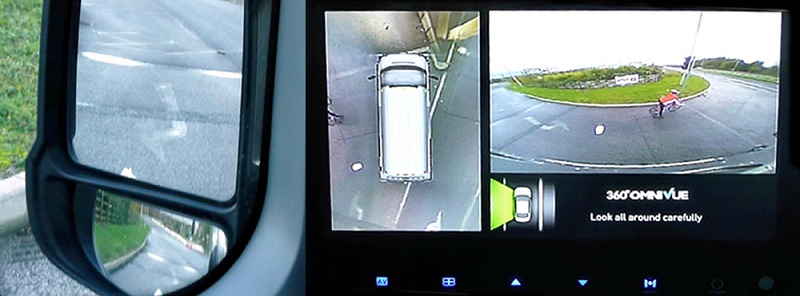ALREADY proving their worth in cars and trucks, it’s vans next for 360° camera system safety says the SMMT.
It’s a logical progression, with a record four million-plus vans now on our roads and increasing calls for fleet operators to be fully accountable, especially in the burgeoning home delivery sector, onboard imaging could soon be seen as essential for both road safety and fleet monitoring purposes.
The onboard imaging market has advanced rapidly from the reversing sensors, through to their replacement with reversing cameras, with the introduction of dash-mounted screens along the way. And that’s just covering the rear of the vehicle. Vehicle-mounted cameras have multiplied and are now found not just at the front, but also at the sides of cars to allow all-round, or 360° vision.
This type of technology is typically still optional on most passenger cars, but the market is moving quickly and manufacturers don’t want to be left behind. And this shift extends to those producing commercial vehicles.
With the van driver’s limited visibility by the windowless nature of the vehicle, it’s just a matter of when, not if, all-round camera technology will reach the commercial vehicle market.
Currently, reversing cameras are still only optional for many vans and LCVs, but in the medium term they could become standard (or even mandatory) kit. It stands to reason, then, that giving drivers complete, 360° vision of the vehicle is only a matter of time.
Those questioning the logic (and, now doubt – being budget-bound, the cost) behind the adoption of 360° camera systems might like to consider the benefits.
First of all there’s the obvious safety advantage – multiple cameras on vehicles have helped to reduce/avoid accidents when parking or manoeuvring in passenger cars, and the same is expected in commercial vehicles.
Their use protects not only the driver and his vehicle, but also other road users and pedestrians – the evolution of blind spot systems and of reversing cameras have proven this. Given that vans and LCVs have more blind spots, 360° cameras are likely to be of even greater benefit to this class than cars, especially as manufacturers work to improve night, glare and poor weather vision, which are currently the main criticisms of the systems.
Then there are the wider operational benefits that 360° cameras can bring. Reducing accidents means reduced risk of insurance claims – and therefore a possible cost-saving through lower premiums – and the vehicle downtime while repairs are made after an accident.
When weighing up the pros and cons of picking camera technology from a vehicle’s options list, these considerations can be key and ultimately cameras can pay for themselves over the lifetime of the vehicle.
One manufacturer that has seen the progression in camera technology through to 360° systems is Mercedes-Benz. The system is now available on a number of models as an option, including the Vito van’s sister vehicle, the V-Class.
According to the company, “the ‘Parking package’ with 360° camera, incorporating Active Parking Assist and a 360° camera, takes the strain off the driver when searching for a parking space, entering and leaving parking spaces, or manoeuvring.” There was no word as to when this technology might be seen on LCVs from the German manufacturer, but it wasn’t ruled out.
The forward march of 360° camera systems is more advanced in the HGV market than it is in the LCV market, with many manufacturers extolling the virtues of their systems at the CV Show earlier this year – proof that safety-related cameras are a growing requirement for some operators.
When indicating, a side-view camera is displayed to ensure there are no blind-spots. Similarly, when reversing, the rear camera is displayed
A camera tech company that already has a relationship with a large scale truck manufacturer is Trailer Vision. A supplier of advanced camera systems – including the 360° Omni-Vue unit – Trailer Vision offers a number of specific items to MAN for its trucks, including single and two-camera systems and a sensor kit. The company is now hoping that a product designed specifically for the van, campervan and leisure market – Omni-Van will yield similar results.
Based on the Omni-Vue, Omni-Van uses the same technology, but the cameras and cables have been redesigned to suit LCV applications and to simplify the installation process. The system ECU is much smaller and operates from 12V only, resulting in a very cost-effective product.
The output from the cameras is a bird’s eye view that is displayed on the dash-mounted screen, but a single camera view is also used, which is triggered automatically. This means that when indicating, a side-view camera is displayed to ensure there are no blind-spots. Similarly, when reversing, the rear camera is displayed.
Ongoing development is good news for the van market when it comes to 360° cameras. “The development of Omni-Van has brought the original price of the Omni-Vue system down from around £1,500 to a much more affordable £595,” said an Omni-Vue spokesman. “This has made it far more appealing to customers and more operators are seeing the benefits of the camera system.”
Omni-Van already has high profile delivery operator DHL among its clients, but is now talking to vehicle manufacturers about supplying the cameras as options on vans.
“In a similar way to how we operate with MAN, we hope that Omni-Van can be rolled out to some of the van and LCV OEMs.”
For added peace of mind, the camera can be used with a two-channel or four-channel recordable video unit (500GB to 1TB HD) ensuring that all incident or accident evidence is recorded. Trailer-Vision operators will find this particularly attractive as it will help to reduce both false claims (‘crash for cash’ situations) and insurance premiums.








Leave A Comment